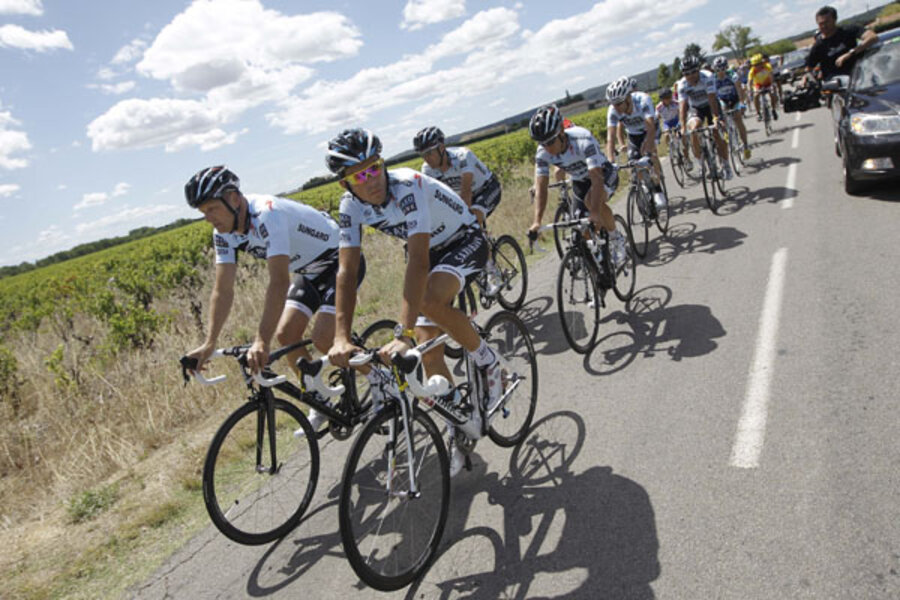A day off at the Tour de France: Not exactly restful
Loading...
| Montpellier, France
There’s no racing today at the Tour de France: the cyclists – from race leader Thomas Voeckler to last-placed Andrey Amador – have a much-needed day off.
It is the second of two rest days during this three-week Tour, which ends next Sunday in Paris.
This strategically placed pause is a chance for riders and team staff to recharge before the grueling Alps stages later this week.
It will be far from a spa day, however.
On rest days, cyclists keep a busy schedule. It’s just a lighter version of their race routine: riding bikes, talking to press, and trying to stay off their feet. Sometimes, though, routines are interrupted.
Spaniard Juan Antonio Flecha, a rider for Team Sky, couldn’t have guessed he’d spend part of the first rest day in a hospital.
But after being clipped by a French television car during last Sunday’s Stage 9, he was on the doctor’s table being examined for broken bones, not in the saddle, during his team’s rest-day ride.
“You’d like to keep the routine, of course, but this morning I had other things to do besides ride my bike,” he told the Monitor last Monday.
It could have been worse for Flecha. The first fatality in Tour history happened on a rest day in 1910 – France’s Adolphe Hélière was stung and killed by a jellyfish while swimming in the Mediterranean.
A typical day
Jellyfish and crashes aside, a typical rest day starts with a training ride. Each team will pedal for about two hours; that's a walk in the park compared to a typical five-hour Tour stage.
The ride is a chance for cyclists to flush out lactic acid and keep their minds focused on racing.
Some riders choose to train for longer. When Spain’s Alberto Contador and his Saxo Bank-Sungard team finished their 25-mile ride during last Monday’s rest day, one cyclist – Richie Porte – continued climbing the Cantal mountains in south-central France.
Porte was inspired to continue by the verdant landscape, which reminded him of his native Tasmania.
“It was beautiful out there,” he told the Monitor. “And actually, the further I went, the better my legs felt.”
After the training ride, cyclists return to the team hotel. There, they see the team physiotherapist and masseuse – just as they do after a stage of the Tour.
Press-conference hopping
The team hotels are hives of activity on rest days: sport directors hold meetings, mechanics repair equipment, and journalists camp out in the lobby, waiting for a quote and filing stories.
Indeed, even on rest days, media relations occupy cyclists’ time.
Supporting riders will chat with groups of reporters, record radio interviews, or shoot promos for television channels.
Yellow jersey contenders, more focused on resting, hold large press conferences.
They’re usually staggered throughout the day, so journalists hustle from one team hotel to the next, hoping for face time with race leaders.
Last Monday, Alberto Contador spent an hour fielding questions from the nearly 100 media members crammed into a humid hotel meeting room.
Many queries were about his rival Cadel Evans, an Australian who rides for Team BMC. Two hours later, at a hotel 30 miles south, the same journalists were asking Evans about Contador.
Time with family, pets
At 34, Evans has been through his fair share of rest days at the Tour. He told The Monitor that when he was younger, he would over-extend himself and didn’t properly “manage his time.”
Now, he has his schedule down pat. Like many riders, he spends time with family.
During this Tour’s first rest day, Evans passed the afternoon in his hotel room, talking with his wife and playing with their dog, Molly.
“It was very relaxing,” he said. “[It] was actually one of the better rest days I’ve had.”
From 14 rest days to two
In the early editions of the Tour de France, which was first raced in 1903, there were many more rest days. Stages would often run overnight, so the cyclists would need the next day to recover from the punishing ride.
The 1911 edition had an incredible 14 rest days, according to Jeremy Little’s Le Tour: A Century of the Tour de France. Today, the number of rest days is typically two.
Though teams and riders are never able to truly take a day off during the race, that hasn’t stopped some from trying.
Last week, American team Garmin-Cervélo sequestered itself at a small château and declined to hold a press conference. Removed from media scrutiny, cyclists went on a training ride and recuperated from crashes with lunch on a sunny patio overlooking the château’s lawns.
Today’s rest day will likely be less relaxing for Garmin riders. The team, also sponsored by burrito restaurant chain Chipotle, is offering free burritos to the press at a winery in Provence.





